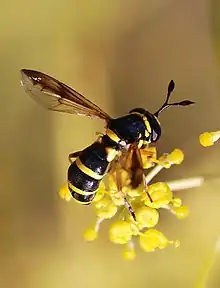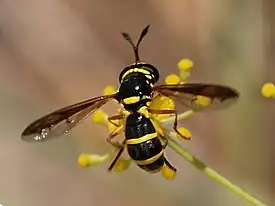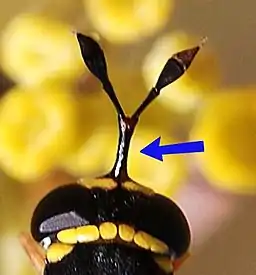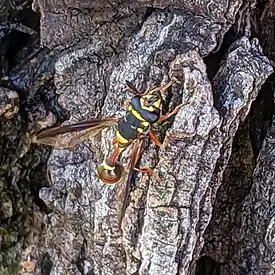Cerioidini
Cerioidini is a widespread tribe of around 222 species of hoverfly.[1] Cerioidini are mistaken for wasps for which they are effective mimic. Cerioidini have antennae with a terminal style and have somewhat elongate and basally constricted abdomens, only slightly in Ceriana, but pronounced in most Sphiximorpha; and Polybiomyia, and extremely in Monoceromyia. [2] Larvae live mostly within tree sap associated with tree wounds or putrefying pockets of water in tree cavities. [3]
| Cerioidini | |
|---|---|
 | |
| Ceriana vespiformes | |
| Scientific classification | |
| Domain: | Eukaryota |
| Kingdom: | Animalia |
| Phylum: | Arthropoda |
| Class: | Insecta |
| Order: | Diptera |
| Family: | Syrphidae |
| Subfamily: | Eristalinae |
| Tribe: | Cerioidini Wahlgren, 1909 |
| Genera | |
| |
Description
This family is distinguished by anatomy and coloration that has evolved to be wasp mimics. The antennae are long and thin with a terminal arista (see gallery) suggestive of wasp antennae that are also long. The arista of the antennae is terminal. The elongate antennae has arisen independently in other genera such as Mocrodon although in that genera the arista is not terminal. The flagellum is always elongate while the scape and pedicel are elongated in different ratios that are helpful in distinguishing the various genera. an elongation of the front, the frontal prominence adds to the elongation of the antennae but is reduced or inconspicuous in some genera (see table below)The face is elongated with coloring that sometimes has the appearance of the wasp mandibles. These flies have no mandibles. The abdomen is elongated often constricted in the first and/or second segments (see table below). The anterior half of the wing is commonly darkly colored while the posterior half is usually clear. The effect is the appearance of a dark forewing and a clear hind wing, as in wasps. When captured, the fly also has some behavioural mimicry, such as a stinging motion of the abdomen. These flies have no actual stinger. The overall coloration is very wasp-like, often black with yellow rings on the abdomen and strong markings on the thorax and face. Wing venation characteristics are of taxonomic value. The cross-vein r-m is at or beyond the middle of the discal cell. Cells r1 and r2+3 are open, while cell r4+5 is closed near the margin of the wing. Vein R4+5 can be straight, looping with or without a spur vein. [4] [5] [6]
Gallery
_ornata_(Cerioides_ornata)_-_Flickr_-_gailhampshire_(1).jpg.webp) Wasp-mimic Ceriana ornata_
Wasp-mimic Ceriana ornata_ Ceriana alvesgaspar
Ceriana alvesgaspar Frontal prominence of Ceriana
Frontal prominence of Ceriana Cerioidini antennae diagram
Cerioidini antennae diagram_wing_veins.svg.png.webp) wing veination
wing veination.jpg.webp) Sphiximorpha subsessilis
Sphiximorpha subsessilis Polybiomyia_bellardii
Polybiomyia_bellardii
Genera characteristics
| Genus | frontal prominence | abdominal segment 1 | abdominal segment two constriction | abdominal segment 2 length | paraface | other |
|---|---|---|---|---|---|---|
| Ceriana | as long as scape | same size as segment 2 | not constricted | wider than long | very short paraface | looping in third vein R4+5 with spur branch projecting into cell r4+5 |
| Monoceromyia | as long as scape | wider than segment 2 | strongly constricted | longer than wide | loop of vein R4+5 without Spur branch | |
| Polybiomyia | absent or very short | shorter than segment 2 | strongly constricted | longer than wide | vein R4+5 not looping | |
| Primocerioides | shorter than scape | not constricted | wider than long | long paraface and large anterior tentorial pit | eyes and face pilose, vein R4+5 straight | |
| Sphiximorpha | shorter than scape | wider than 2 | slightly constricted anteriomedially | longer than wide | long paraface and large or deep anterior tentorial pit. | Facial tubercle weak to nearly absent. vein R4+5 not looping. |
References
- Ricarte, A., Marcos-garcía, M. A., Rotheray, G. E. & Hancock, E. G. (2007). The Early Stages and Breeding Sites of 10 Cerioidini Flies (Diptera: Syrphidae). Annals of the Entomological Society of America 100(6):914-924 doi:10.1603/0013-8746(2007)100[914:TESABS2.0.CO;2]
- Vockeroth, J.R. (1987). Manual of Nearctic Diptera, Volume 2 (PDF). Canada: Research Branch, Agriculture Canada. p. 668. ISBN 0-660-12125-5.
- Heiss, Elizabeth Madeleine (1938). "A classification of the larvae and puparia of the Syrphidae of Illinois exclusive of aquatic forms". Series: Illinois Biological Monographs. 16: 1–142. end of template cite journal
- Ferguson, E. W. (1926). "Revision of Australian Syrphidae (Diptera). Part i." (PDF). Proceedings of the Linnean Society of New South Wales. 51: 137–183.
- Brunetti, Enrico (1923). Diptera Vol. III. Pipunculidae, Syrphidae, Conopidae, Oestridae. Vol. 3. London, England: Taylor and Francis. pp. 1–424.
- Shannon, Raymond (1927). "Notes on and descriptions of Syrphid flies of the subfamily Cerioidinae". Journal of the Washington Academy of Sciences. 17: 38–53.